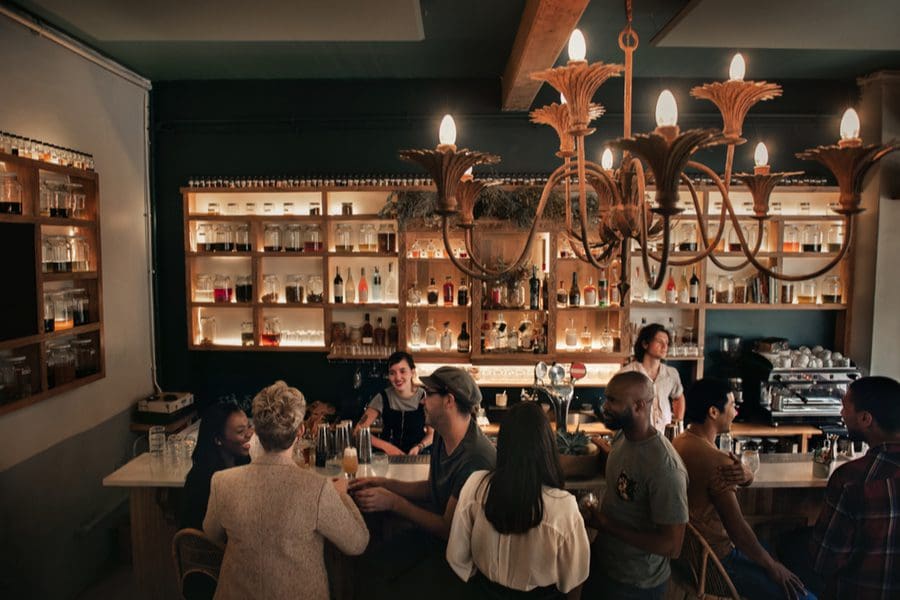Which public spaces pose little risk of spreading coronavirus and which should you avoid? Four Michigan public health experts rank several activities from 1 to 10, with 10 being the riskiest. “Anything where there’s a crowd of people, without risk reduction strategies, it’s a 10,” Sims said. For the full scoop on how these experts evaluate the risk of activities from gyms to restaurant takeout, see the MLive story here.
Doctors Interviewed:
- Matthew Sims, Beaumont Health director of infectious disease research
- Dennis Cunningham, McLaren Health Care medical director for infection prevention
- Mimi Emig, retired infectious disease specialist with Spectrum Health
- Nasir Husain, Henry Ford Macomb medical director for infection prevention
Risk level: 9
Bars are very risky. Mingling and drinking mean fewer precautions at bars. People let their guard down when drunk. Even if large music concerts are held outside, people are packed in and drinking alcohol.
Risk level: 8
Risk can be reduced when seats are arranged the right way and everybody wears a mask, but if churches add singing, the risk is on a par with bars. Sports stadiums have crowding and alcohol, along with cheering, yelling and singing. People emit more respiratory secretions when working out and breathing heavily in gyms. Even limiting people, enforcing distancing and disinfecting rides, amusement parks are very risky. A restaurant buffet is riskier than a regular restaurant but limiting people at the buffet and sharing serving utensils can lower risks.
Risk level: 7
Most outdoor recreational activities are low risk but not contact sports like basketball. There’s not many ways to make swimming in a public pool safe, according to the experts. Seeing swimmers wearing masks is highly unlikely, and you can expect crowds. Schools present complications when students often come within six feet of each other for hours.
Risk level: 6
The right-in-your-face nature of haircuts and hairstyling makes social distancing impossible and hair salons and barbershops high risk. Go to a salon that doesn’t use hairdryers that could potentially circulate the virus. Older people and others at a higher risk for COVID-19 should get a first-in-the-morning appointment when the salon or barbershop should be most virus-free.
Bet on crowds, alcohol, and loud talking in casinos. Eating inside at a restaurant means you breathe air recirculated throughout the building. Playgrounds are a worry because enforcing health precautions on children is difficult. Pontoon boat rides can be risky if you’re going for a boat ride with a big group of people. Retrofitting movie theaters is going to be tough when precautions are needed such as spacing out seating, making people wear masks and limiting when people can get up and walk by others who are seated.
Risk level: 5
Dinner parties in a house and barbecues in a backyard ranked equally risky although outdoor gatherings make staying six feet apart easier. Limiting the number of people in stores and requiring masks can lower the risk at shopping malls. Complications arise at beaches where limiting numbers and enforcing precautions is difficult. Bowling alleys are not known for high levels of air filtration and circulation.
The experts were divided on the safety of flying in an airplane. Two called it medium risk, one said it’s low risk and the other said it’s high risk. One said the issue is that most people don’t wear masks correctly and lots of people are together for long periods of time.
Risk level: 4
Experts disagreed about the risk level of going to the dentist. Two experts called it low risk, one said it’s a medium risk and the other said it’s high risk. One expert called it a higher risk than getting a haircut and recommends avoiding the dentist for now, unless there’s a specific issue. Walking around a busy downtown carries lower risk because it’s outside and you can steer clear of non-masked people. Offices are lower risk than shops and restaurants because employers can better enforce distancing and masking. A doctor’s waiting room could be risky if they ignore precautions. Eating outdoors at a restaurant is safer than eating inside.
Risk level: 3
Grocery stores are another place where risk is much higher if many people aren’t wearing masks. A family camping by themselves is pretty safe, but big camping events or overnight camps for children pose higher risks. Staying at a hotel that has contactless check-in can lower risk. Golfing is a low risk, outdoors, non-contact sport with small groups of people. Don’t share your golf cart. Libraries and museums aren’t typically super crowded areas and can enforce masks and distancing better than many other spaces.
Risk level: 2
You don’t come into contact with many people and aren’t near them for long when walking, running and biking on trails. Putting gas in your car is low risk because you are outdoors, not close to anybody and not at the pump long. Be sure to wear gloves or use hand sanitizer before and after pumping.
Risk level: 1
With curbside pickup and touchless payment, there’s less concern about takeout from a restaurant. Playing tennis is typically outdoors and there’s only two to four people on a court, so the risk is low. Be sure to use your own racket, or bring wipes. Don’t touch your face after touching the ball – and be sure to wash your hands after.







Ms. Parham has done an excellent job of researching all the medical evealuations and compiling them according to RISK! Great work! Thank you.